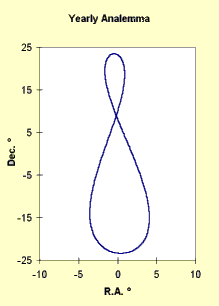| Twilight Name |
Sun's Distance Below Horizon |
Definition |
| Sunset |
0°
50' |
Because
of atmospheric refraction, the sun's upper limb appears
to be touching the horizon. |
| Civil |
6° |
The
time after which city streetlights are lit, automobiles
begin using headlights, in general, the time after which
we use artificial light. |
| Nautical |
12° |
The
best time for a sailor to use a sextant to take a star
sight — the horizon is still visible, and many
navigational stars are also visible. Earlier, some
important navigational stars will not be visible. Later,
the horizon becomes too difficult to see through the
sextant. |
| Astronomical |
18° |
After
this time, the sky is dark enough for astronomers to make
productive use of powerful telescopes. Only the faintest
glow is visible near the sun's position. |

 Share This Page
Share This Page
 Share This Page
Share This Page Sun Calculator Help
Sun Calculator Help

 Share This Page
Share This Page